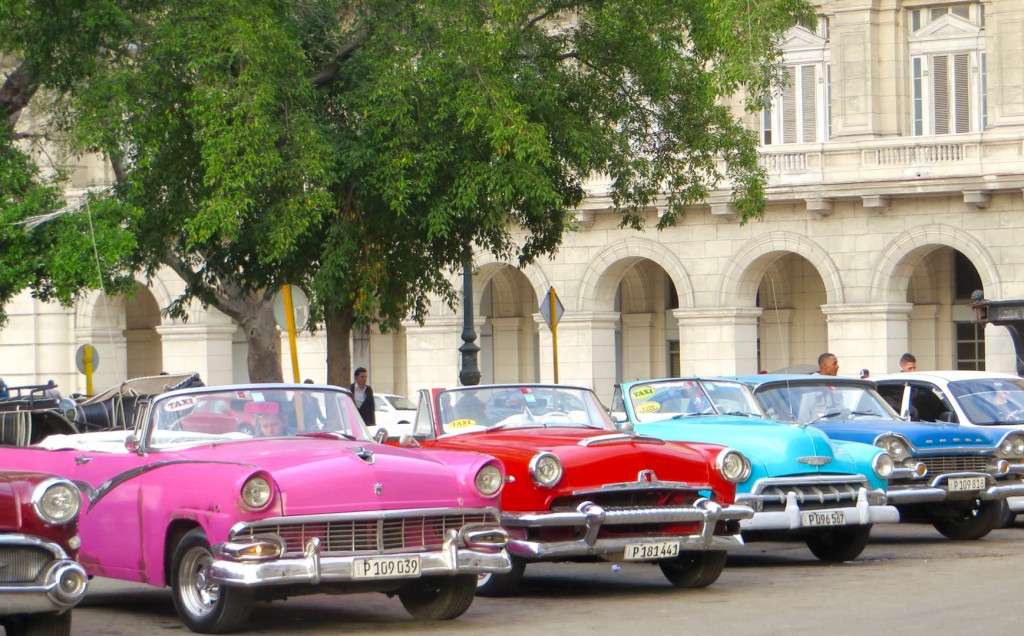 It’s easy to be taken with Cuba. The vintage American cars. Cuban jazz on every street corner. Art fashioned from repurposed detritus—hubcaps, scrap metal, broken glass. Beautiful colonial, art deco, and baroque architecture graces the cities, along cobblestone streets, tiled floors, walls painted in pastel shades of green and pink and baby blue. Elegant ceiba trees and stately royal palms. Aquamarine water and white sand. Visitors sip coffee at sidewalk cafés. We stayed in lovely renovated hotels. Every meal came with a mojito or Cuba libre “welcome” drink.
It’s easy to be taken with Cuba. The vintage American cars. Cuban jazz on every street corner. Art fashioned from repurposed detritus—hubcaps, scrap metal, broken glass. Beautiful colonial, art deco, and baroque architecture graces the cities, along cobblestone streets, tiled floors, walls painted in pastel shades of green and pink and baby blue. Elegant ceiba trees and stately royal palms. Aquamarine water and white sand. Visitors sip coffee at sidewalk cafés. We stayed in lovely renovated hotels. Every meal came with a mojito or Cuba libre “welcome” drink.
Cuba is a country of near one hundred percent literacy. Free health care and education. The ubiquitous image of Che Guev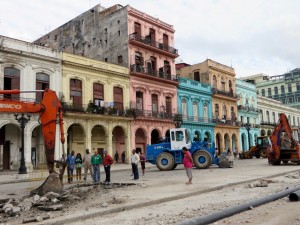 ara on t-shirts and hats and murals as if every one of us has a revolution bubbling up inside.
ara on t-shirts and hats and murals as if every one of us has a revolution bubbling up inside.
Against all odds—including a fifty year US embargo—Cuba is the little engine that could.
It’s easy to be captivated by the spirit of a people who have suffered extreme poverty, tyranny, fear, the wrenching apart of families. One million Cubans—nearly a tenth of the population—fled the country in the years immediately following the revolution in 1959. Everyone has an anti-Castro relative living in Miami. But every Cuban has a roof over their head. We saw almost no begging on the streets. No homeless men sleeping on park benches. The streets of Havana are clean but for the rubble of renovations and repair.
Cubans are master mechanics, cobbling together a stove or a washing machine from recycled or welded parts. We saw a TV jerry-rigged using a Russian CRT computer monitor; it took five minutes to warm up, but the picture was clear enough to watch Cuba’s national sport—baseball.
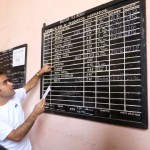 While the government sets salaries, those Cubans able to capitalize on the tourist trade are faring much better. A fisherman we met makes more than his daughter who’s a doctor. Engineers drive taxis after hours. Women working in a state-run cooperative weave baskets eig
While the government sets salaries, those Cubans able to capitalize on the tourist trade are faring much better. A fisherman we met makes more than his daughter who’s a doctor. Engineers drive taxis after hours. Women working in a state-run cooperative weave baskets eig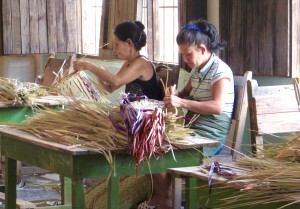 ht hours a day. At night, they go home and continue their work, weaving for the tourist trade.
ht hours a day. At night, they go home and continue their work, weaving for the tourist trade.
Every Cuban is provided with a ration booklet to buy their allotted five eggs a month, four ounces of coffee, sugar, oil, rice. When the food runs out, maybe they have a chicken in the yard or a small garden. And yet, the paladares—privately owned restaurants for the tourists—serve overflowing plates of shrimp and lobster and steak on delicately flowered china, with hand-woven tablecloths and napkins, and crystal stemware. The privilege of being a tourist is striking.
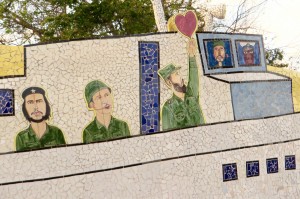 Back in my comfortable home in the US, I’m inspired by the Cubans—a proud people determined to overcome adversity. This is Cuba on the verge of success and I wish them well. But I’m troubled by the inequities and the tyranny of a not-so-distant past. There’s a tendency to overlook the years of torture, a reign of terror presided over by Fidel Castro. The same Castro who promised days after the revolution, “Cuban mothers let me assure you that I will solve all Cuba’s problems without spilling a drop of blood.”
Back in my comfortable home in the US, I’m inspired by the Cubans—a proud people determined to overcome adversity. This is Cuba on the verge of success and I wish them well. But I’m troubled by the inequities and the tyranny of a not-so-distant past. There’s a tendency to overlook the years of torture, a reign of terror presided over by Fidel Castro. The same Castro who promised days after the revolution, “Cuban mothers let me assure you that I will solve all Cuba’s problems without spilling a drop of blood.”
A tyrant is keenly aware of what the people want to hear, and he’ll offer it to them, no matter the truth–something we should take to heart back home.